Good tree planting practices include good planting stock, a well-selected and properly prepared site, proper planting methods, and adequate protection and care of the tree seedlings before and after planting. Failure in any of these planting practices often results in unsatisfactory survival or growth, or even complete failure. Before you order seedlings, you need to know the answers to these questions:
- What species grow well in my area?
- What species are best for my needs?
- Will this species grow in my soil?
- How many trees can I plant and properly maintain?
- How and when do I order my trees?
This guide helps answer these questions. If you are planning a large planting, seek advice from a professional forester. Contact the MU Extension center or the Missouri Department of Conservation office in your county for help finding one.
What species grow well in my area?
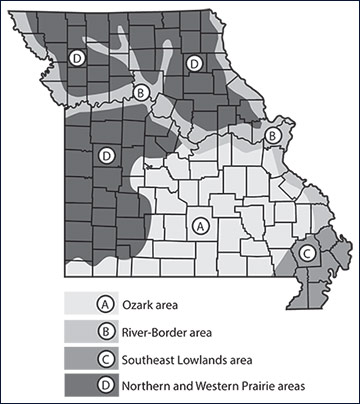
Trees survive and grow best when planted under conditions similar to those where they occur naturally. Missouri is part of the great central hardwood forest region and has more than 160 native tree species.
Trees preferring similar conditions form forest communities. Soils and climate create four broad tree-growing areas in the state (Figure 1). These areas denote major changes in general tree-growing conditions. However, each area contains a wide array of local site variations that must be considered when selecting species to plant.
(A) Ozark area
The Ozark area is the most heavily wooded part of the state. At one time, it was nearly all forested. The area now is largely a mix of open pastureland and forest. The soils are often thin and rocky. This area has the greatest diversity of tree and shrub species and much of it can be used to grow trees for wildlife and commercial forest products. Undesirable sprouts and other competing woody growth may need to be eliminated or controlled. Desirable species typically found on the better sites include scarlet, northern red, Shumard, black, and white oaks. Shagbark hickory, white ash, blackgum, river birch, eastern redcedar, and shortleaf pine are other common species. In the eastern Ozarks, cherrybark oak, sweetgum and tulip poplar are common. Shrub species include flowering dogwood, aromatic sumac, hazelnut, redbud, ninebark, wild plum and deciduous holly. Site preparation in old fields is commonly accomplished either by mechanical disking or by applying a broad-spectrum contact herbicide in the fall before spring planting.
(B) River-Border area
Areas bordering the Missouri and Mississippi rivers and their tributaries are a high-priority area for tree planting. Many good sites exist for the production of high-quality hardwood species, especially along the big rivers. Tree and shrub plantings can slow flood waters and protect valuable farmland from damaging floods, erosion and sand deposits. Soils are deep, fertile, river deposits. Typically on the lower ground, common species include cottonwood, silver maple, hackberry, sycamore, and green ash. On higher ground, pecan, pin oak, black walnut, swamp white oak, northern red oak, and persimmon are among the dominant species. It is essential to prepare sites properly before planting, especially in the bottomlands, because heavy weed competition will severely limit survival and growth. After planting, follow up with regular weed control using disking or chemicals until trees are at least 4 to 6 feet tall.
(C) Southeast Lowlands area
The Southeast Lowlands area includes the flat lowlands with deep river-deposited soil and Crowley's Ridge, a hilly area of deep rich soils. Nearly all of this area was once forested. Lowlands species include baldcypress, hackberry, cottonwood, silver maple, sycamore, pin oak, willow oak, overcup oak, sweetgum, and green ash. On the higher ground, tulip poplar, white ash, American beech, and a variety of hickory species are common. Site preparation and weed control are similar to those for the River-Border area.
(D) Northern and Western Prairie areas
In general, the soils and climate conditions of the Northern and Western Prairie areas are not as favorable to tree growth as the rest of Missouri. Site and species selection are crucial, and after-planting care needs special emphasis. Common species in the uplands include bur, white, swamp white, Shumard, black, and northern red oaks; Kentucky coffeetree; basswood; white and green ash; and black walnut. Sycamore, pecan, pin oak, green ash, silver maple, shellbark hickory, hackberry and cottonwood are common lowlands species. Opportunities abound for flood-protection plantings along streams and rivers in these areas. Wildlife food and cover plantings are moderately successful and much needed.
What species are best for my needs?
All trees have their uses. Tree uses include wood products, shade or ornamental beauty, food and shelter for birds and animals, protection of soil, and modification of temperature or noise levels. All trees filter the air and produce oxygen. Tables 1 through 3 show common uses of some of the major species planted in Missouri. The Missouri map beside each species description shows where that species is likely to thrive.
Table 1. Primary uses of large conifers.
| Species | Common uses | Wildlife benefits | Mature height (feet) | |||||
|---|---|---|---|---|---|---|---|---|
| Windbreaks | Erosion control | Reforestation | Wetland restoration | Ornamental or shade | Food | Cover | ||
| baldcypress | X | X | X | X | X |
90–100 |
||
| eastern redcedar | X | X | X | X |
40–50 |
|||
| eastern white pine | X | X | X | X |
80–100 |
|||
| loblolly pine | X | X | X | X |
90 |
|||
| shortleaf pine | X | X | X | X |
80–100 |
|||
Table 2. Primary uses of large hardwood trees.
| Species | Common uses | Wildlife benefits | Mature height (feet) | |||||
|---|---|---|---|---|---|---|---|---|
| Windbreaks | Erosion control | Reforestation | Wetland restoration | Ornamental or shade | Food | Cover | ||
| black cherry | X | X | X | X |
60 |
|||
| black locust | X | X |
50–60 |
|||||
| black walnut | X | X | X |
80–90 |
||||
| blackgum | X | X | X | X | X |
65 |
||
| eastern cottonwood | X | X | X | X | X |
100 |
||
| hackberry | X | X | X | X | X | X |
90 |
|
| bitternut hickory | X | X |
70 |
|||||
| mockernut hickory | X | X |
70 |
|||||
| pignut hickory | X | X |
80 |
|||||
| shagbark hickory | X | X |
70 |
|||||
| shellbark hickory | X | X | X |
100–110 |
||||
| Kentucky coffeetree | X | X | X |
70–90 |
||||
| black oak | X | X | X |
85 |
||||
| burr oak | X | X | X | X | X |
80 |
||
| cherrybark oak | X | X | X | X | X |
100 |
||
| chinkapin oak | X | X | X | X |
70 |
|||
| northern red oak | X | X | X | X | X | X |
90 |
|
| Nuttall oak | X | X | X |
90–100 |
||||
| overcup oak | X | X | X | X |
70 |
|||
| pin oak | X | X | X | X | X |
70–80 |
||
| Shumard oak | X | X | X | X | X | X | X |
80–100 |
| swamp white oak | X | X | X | X | X | X |
70 |
|
| white oak | X | X | X | X |
85 |
|||
| willow oak | X | X | X | X | X | X | X |
70 |
| Osage-orange | X | X |
40–50 |
|||||
| pecan | X | X | X | X |
90 |
|||
| persimmon | X | X | X | X | X |
60–70 |
||
| red mulberry | X | X |
50 |
|||||
| river birch | X | X | X | X | X |
60 |
||
| sandbar willow | X | X | X |
30 |
||||
| silver maple | X | X | X | X |
90 |
|||
| sweetgum | X | X | X | X |
80–100 |
|||
| sycamore | X | X | X | X |
80–100 |
|||
| yellow-poplar | X | X | X |
90–100 |
||||
Table 3. Primary uses of small trees and shrubs.
| Species | Common uses | Wildlife benefits | Mature height (feet) | |||||
|---|---|---|---|---|---|---|---|---|
| Windbreaks | Erosion control | Reforestation | Wetland restoration | Ornamental or shade | Food | Cover | ||
| arrowwood | X |
15–20 |
||||||
| blackhaw | X | X |
20 |
|||||
| buttonbush | X | X | X | X |
15–20 |
|||
| Carolina buckthorn | X | X |
25 |
|||||
| chokecherry | X | X | X | X |
10 |
|||
| deciduous holly | X | X | X | X | X |
25 |
||
| flowering dogwood | X | X | X |
35–40 |
||||
| gray dogwood | X | X | X | X |
10 |
|||
| roughleaf dogwood | X | X | X | X |
20 |
|||
| silky dogwood | X | X | X | X | X |
10 |
||
| elderberry | X | X | X | X |
10 |
|||
| false indigo | X | X | X | X |
10–15 |
|||
| Washington hawthorn | X | X | X | X |
25 |
|||
| hazelnut | X | X | X | X | X |
10 |
||
| ninebark | X | X | X | X | X |
5–10 |
||
| Ohio buckeye | X | X | X |
50 |
||||
| Ozark witch-hazel | X | X | X | X | X |
10–15 |
||
| pawpaw | X | X |
20 |
|||||
| eastern redbud | X | X | X | X |
30 |
|||
| serviceberry | X | X | X |
25 |
||||
| fragrant sumac | X | X | X | X | X |
5–10 |
||
| smooth sumac | X | X |
10–15 |
|||||
| eastern wahoo | X | X |
10–15 |
|||||
| wild plum | X | X | X | X | X |
25 |
||
Large trees — conifer
baldcypress
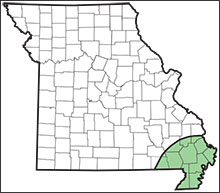
Baldcypress is a large tree that may live more than 1,000 years. It is commonly associated with southeastern swamps, but adapts easily to a wide range of sites. Young trees grow rapidly on good sites and may reach 20 feet in height in 10 years. Its bark is cinnamon-red, and it has small leaves that are arranged in featherlike fashion along two sides of small branchlets. The branchlets fall in the autumn with the leaves still attached. The wood is extremely durable.
eastern redcedar
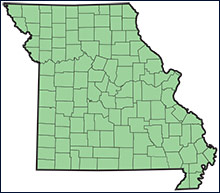
Eastern redcedar is found in every county in the state on nearly all classes and conditions of soil. It seems to thrive on barren soils where few trees are found. It is relatively slow-growing on most sites and generally a medium-sized tree. Its heartwood is red, durable and aromatic, and is used in cedar chests, closets and novelty items. Its dense evergreen foliage makes it a valuable windbreak, screen or hedge tree. The pale blue, berrylike fruit is a favorite winter food for birds. Birds tend to scatter the seeds widely, causing invasion of the tree into pastures and other areas where it may be unwanted. It is susceptible to damage by even light fires.
eastern white pine
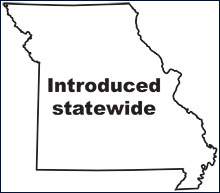
The eastern white pine is a tall, stately tree with an attractive conical shape and branches nearly to the ground in open stands. It makes an excellent windbreak throughout the state. It adapts to a variety of sites but prefers moderately moist, sandy loam soils. White pine may have difficulty surviving in Missouri's dry climate and clay soils. The species provides good cover for wildlife.
loblolly pine
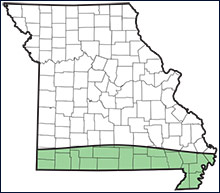
Native throughout the southern U.S., loblolly pine was introduced and grows well in southern Missouri. This fast-growing pine is an important timber tree for lumber and pulp. It looks like shortleaf pine but has longer needles and a larger cone. It grows on a wide variety of sites, including poor, dry upland soils and rich bottomland soils.
shortleaf pine
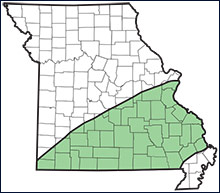
Shortleaf is the only pine native to Missouri. It does very well on dry, upland sites in the Ozarks. It probably should not be planted north of the Missouri River. Avoid shaded locations and claypan soils. It prefers acid soils.
Large trees — hardwoods
black cherry
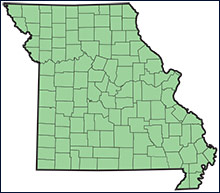
Black cherry is found statewide on a variety of sites, including moist, fertile bottoms and dry, gravelly upland soils. The lumber is second only to walnut in demand as a fine hardwood. The flowers are white clusters 2 to 4 inches long. The red-to-black fruits ripen in August and are abundant nearly every year. Numerous wildlife species eat the fruit.
black locust
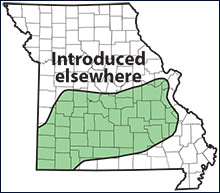
Black locust produces fragrant white or cream-colored flowers and has very hard, strong, durable wood. Its primary uses are for posts, erosion control, fuel wood and, because it is a legume with fibrous roots, soil improvement. Its branches are armed with pairs of short, sharp spines. Because black locust spreads easily from root runners, it can become a nuisance. On poor soils, it is usually attacked by locust borers. It is found in Areas A, B, and D but does best on fertile, moist soils of limestone origin.
black walnut
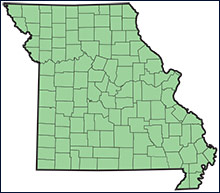
On an individual tree basis, black walnut is one of the most valuable commercial species in the U.S. Valued for its lumber and nuts, it is extensively cultivated statewide. Its fruit, a nut, provides many products and is a staple diet for squirrels. Black walnut grows rapidly on deep, rich, alluvial soils. Growth rates decline rapidly in poor soils.
blackgum
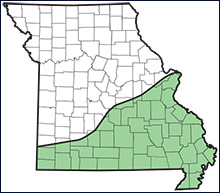
Blackgum occurs naturally south of the Missouri River but has been successfully planted statewide. It is found growing in deep soils along streams and in moist upland soils. The dark purple fruit is eaten by many birds and other wildlife. The leaves are shiny and dark green and turn a brilliant scarlet red in the fall. This tree is often affected by heart rot, making it useful for wildlife species that need dens for nesting and shelter.
eastern cottonwood
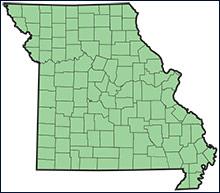
Found along the streams throughout the state, cottonwood is a large, spreading tree with shiny, triangular leaves that turn yellow in the fall. Female trees produce large quantities of cottonlike seeds This tree becomes large and brittle tree, and is relatively short-lived. Cottonwood develops best in deep, silty, sandy or clay-loam soils that are moist but well-aerated. It will survive deep sedimentation. It can be grown from planted cuttings or seedlings.
hackberry
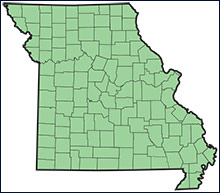
One of Missouri's most common species, hackberry is closely related to the elms. Its bark is grayish and rough, with unique warty projections. In rich bottomlands, where it is commonly found, it may grow to 125 feet in height. It is tolerant of the growth conditions found in urban communities. The fleshy, purple berrylike fruit furnish food for squirrels and birds.
bitternut hickory

Bitternut hickory is usually found along stream banks primarily in the eastern two-thirds of the state. It can also grow on dry sites and grows well on poor soils low in nutrients. Like all the hickories, the wood is hard and durable. It is used to make axles, axe handles, ploughs and drumsticks, and by Native Americans for making bows. The wood is also used for smoking meat. Bitternut hickory seeds and bark are eaten by wildlife.
mockernut hickory
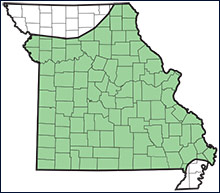
Mockernut hickory occurs nearly statewide, except for the far southeast corner and northwestern counties, in dry upland woods on upper slopes and ridges. Occasionally the species can be found in low woods along streams. Its nuts are eaten by squirrels, mice and deer.
pignut hickory
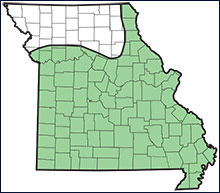
Pignut hickory is a medium-sized tree found mostly in the eastern Ozarks but can be found scattered throughout southern Missouri and in a few counties just north of the Missouri River. It is found on dry upland soils mixed with other hickories and the oaks. Its nuts are eaten by squirrels, mice and deer.
shagbark hickory
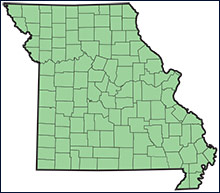
Shagbark hickory wood is used for smoking meat and for making the bows of Native Americans of the northern area. The lumber is heavy, hard and tough. The shagbark hickory's nut is edible and has a very sweet taste.
shellbark hickory
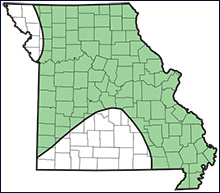
Shellbark hickory, sometimes called big shagbark hickory, is the largest of the hickories. It is found on the fertile bottomlands throughout Missouri, except it is absent from the Ozarks. Although it has similar bark to shagbark hickory, it can be identified by its larger leaves, greater number of leaflets, orange twigs, and large nuts. It has the largest and best tasting of the native hickory nuts. On good bottomland sites, this tree can grow more than 100 feet tall.
Kentucky coffeetree
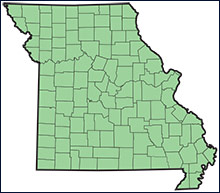
Kentucky coffeetree is found widely scattered throughout the state. It rarely grows in pure stands and is usually found growing on low, rich bottomlands or moist hillsides along with a variety of other hardwoods. This tree is a legume, and the large dark purple pods will often hang on the tree through the winter. Because the tree is scattered, it is of little timber value, but wildlife eat the seedpods. It is sometimes planted as an ornamental because of its heavy twigs and distinctive shape in the winter. It will grow to a height of 85 feet on good sites.
silver (soft) maple

Planted statewide, silver maple will grow in many different soil types but occurs naturally in areas with a good moisture supply throughout the growing season, usually on alluvial soils or soils with imperfect drainage. Silver maple grows rapidly and has been much planted as a shade tree. It has the disadvantage of brittle limbs that are subject to wind and ice breakage. Its silvery leaves turn yellow in the fall. Silver maple is used for timber products, windbreaks and stream bank protection.
sugar (hard) maple
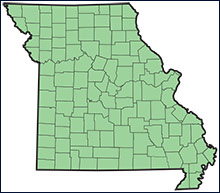
Sugar maple occurs statewide in moist to dry upland forests and along stream banks. It is a popular shade tree known for its brilliant fall colors of yellow, orange and red. However, in Missouri forests and woodlands, because of its ability to grow in the shade of the native oaks, it prohibits the next generation of oaks to survive.
black oak
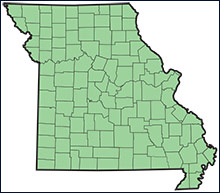
Found throughout the state, black oak can tolerate dry rocky ridges and upper slopes but also grows well on better-quality sites. The lumber is generally low-quality and is used for pallets, railroad ties, rough lumber, and flooring. This oak is a consistent producer of acorns. The acorn is about 3/4 inch long and is eaten by a variety of wildlife.
burr oak

Burr oak is a large oak that is found naturally on fertile, well-drained soils statewide. The acorn is large, up to 1-1/2 inches in diameter, and is half to three-quarters enclosed in a fringed cap. The bark is thick, almost corky, insulating the tree from fire. The wood is used like white oak for lumber, barrel staves, fuel wood, railroad ties, etc.
cherrybark oak
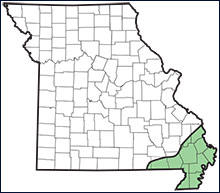
Cherrybark oak is a large oak that is found on ridges and high ground in the Southeast Lowlands area of the state. The name derives from the scaly, reddish-tinged bark's resemblance to the bark of a black cherry. For timber quality, cherrybark oak is one of the most preferred of the lowland red oaks. Consult a forester before undertaking any extensive planting of this species outside of the Bootheel.
chinkapin oak
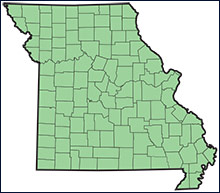
Chinkapin oak is found throughout Missouri mostly on dry upland woods, along bluffs, and in glades. It tolerates very dry, rocky soil but will grow on a wide variety of sites. This tree is in the white oak group. It has silver-gray bark and long, thin leaves. Its nearly black acorns are about 3/4 to 1 inch long and are a favorite food of turkey and deer.
northern red oak

Northern red oak is found statewide, commonly on shallow, rocky soils. It prefers well-drained loam or clay-loam sites. It is found most frequently on northern and easterly aspects, lower and middle slopes, coves and ravines, and valley floors. Its acorns are an important food for squirrel, deer, turkey and other wildlife. It is an important timber product species. The brilliant red color of its autumn leaves and its symmetrical form have made it a widely used shade tree where space is not limited.
Nuttall oak

Nuttall oak is a relatively fast-growing oak that is found in the Southeast Lowlands area of the state. It does well on heavy, poorly drained clay soils. This tree somewhat resembles pin oak. It probably should not be planted outside of the Bootheel.
overcup oak
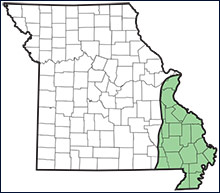
Overcup oak occurs naturally in southeastern Missouri and up the Mississippi River to St. Louis. It grows on wet, poorly drained sites and is one of the most flood tolerant species. This slow-growing tree produces acorns that are almost enclosed in the cap.
pin oak
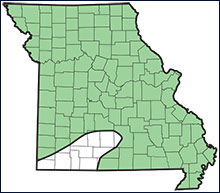
Pin oak is a wetland tree that grows in the bottomlands and borders of swamps but also occurs on poorly drained soils and in fence rows and along draws in nearly every county in the state. Because it is one of the fastest growing oaks and will survive on a variety of soils, it is used extensively as a windbreak and ornamental tree. Pin oak has a single, upright stem with numerous long, tough branches, the lower ones drooping, the middle horizontal, and the upper ascending. It produces very knotty, low-grade lumber.
Shumard oak
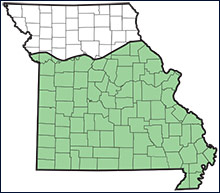
Shumard oak is one of the largest of the southern red oaks. It looks like northern red oak. Native to the southern two-thirds of Missouri, it is found along drainages and broad river bottoms and in upland sites. It can be found in, and will tolerate, a broader range of planting sites than northern red oak. The acorn is smaller and its cap slightly deeper than that of red oak. The wood is commercially valuable. Shumard oak makes a handsome shade tree where there is plenty of space. Its red fall leaf color and symmetrical form make it a desirable shade tree. This species should be more widely planted along with other oaks in reforestation projects.
swamp white oak
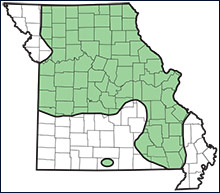
Swamp white oak is a fairly fast-growing, medium-sized tree. It grows naturally in the northern two-thirds of the state along low hills and stream bottoms, but it is adaptable to a wide variety of sites. Despite its name, this species does not naturally grow in swamps. The acorns are a favored fall food of deer, turkey and many other wildlife species.
white oak
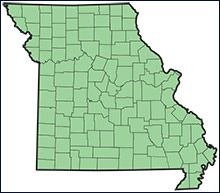
White oak is one of the most common and best-loved Missouri trees. A large tree, it grows best in loamy, well-drained soils in protected coves and on cool slopes, but it is found on many different sites. White oak wood is used in barrels, furniture and numerous other products. Although it is difficult to transplant, white oak becomes a large shade tree once established. Its leaves turn red in the fall.
willow oak
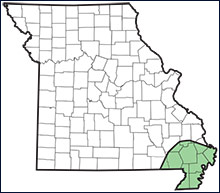
Willow oak is a moisture-loving oak native to the Missouri Bootheel. It does best on poorly drained sites. It will tolerate swamp areas and upland sites with heavy clay soils. The name derives from the unusual leaves for an oak — they look just like willow leaves. This tree is often planted statewide for an ornamental because of its unusual leaves and fast growth. The acorn is one of the smaller of the native oaks and is heavily used by waterfowl and other wildlife. Mature willow oak can grow to 80 feet in height.
Osage-orange (hedgeapple)
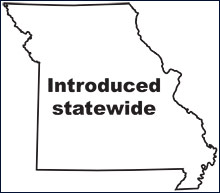
Although probably not native to Missouri, Osage-orange has become naturalized through its use in fence row plantings. It is found most commonly on deep rich soil, but it can grow on a variety of soils. It is extremely hardy and durable, making it suitable for fence posts. It is useful for farm windbreaks, wildlife food and cover, and erosion control. Its shallow root system competes efficiently for available moisture with other plants.
pecan
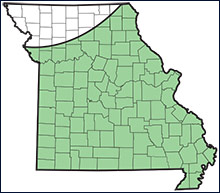
A favorite nut, timber and shade tree of Missouri, the pecan occurs naturally in areas along certain large streams and rivers throughout the state. It is common on well-drained loam soils not subject to prolonged overflow, such as first bottom alluvial soils. It also occurs on certain heavy-textured bottomland soils and some cool, protected slopes. Nut production in native pecans begins when trees are about 20 years old, with optimal seed-bearing age being from 75 to 200 years.
persimmon
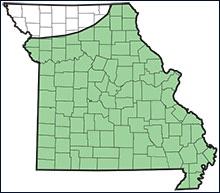
A small to medium-sized tree, persimmon is found on a variety of sites throughout Missouri. It can be found on dry uplands and in rich bottomlands. The male and female flowers occur on separate trees. The fruit can be eaten by humans and is an important fall food for many wildlife species. The wood is one of the hardest of all woods and is used for golf club heads. The bark is dark and broken into deep thick square blocks. The leaves are smooth edged and shiny dark green.
red mulberry
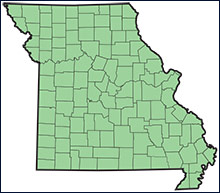
Red mulberry is a medium-sized tree that is found statewide. It prefers good soil but can be found on poor sites. Many animals eat the fruit.
river birch
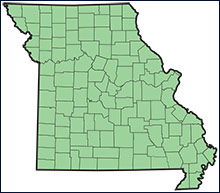
The only birch native to Missouri, river birch is a common lowland and riverbank species. It is a medium-sized tree commonly found in clumps of several trunks. The bark is thin and papery and light pinkish or tan in color.
sandbar willow
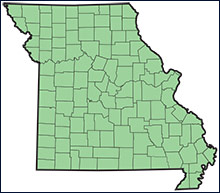
Sandbar willow is a shrublike, thicket-forming willow found statewide. It occurs on sand bars and muddy stream banks. This tree is a good soil binder and bank stabilizer that prevents erosion. The leaves and twigs are browsed by deer.
sweetgum
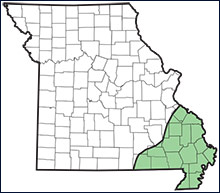
Sweetgum is a timber species whose natural range in Missouri is on rich river bottoms, in swamps subject to frequent overflows, and on drier uplands along streams in the southeast. However, sweetgum adapts to many soils and sites and has been planted statewide for many purposes. It is also tolerant of city environments. Sweetgum is a popular ornamental tree because of its adaptability and its star-shaped leaf, whose fall color ranges from pale yellow to deep bronze.
American sycamore
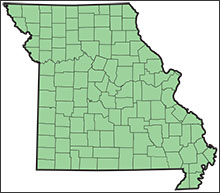
One of the fastest growing trees, American sycamore is a large tree found statewide. It has large leaves and distinctive white and brown bark that is attractive in winter and summer. Its outer bark yearly flakes off in large patches, exposing the nearly white underbark. Because of its high resistance to industrial fumes, it has been used extensively for shade tree plantings at industrial sites where space permits. It is commonly found along streams and in rich bottomlands but does not appear where surface drainage immediately around trees is poor. It is highly susceptible to anthracnose and canker disease. Low-value timber products are produced from sycamore.
yellow-poplar (tulip-poplar, tuliptree)
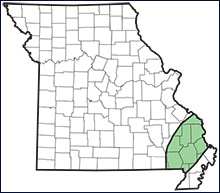
Yellow-poplar's name derives from the yellow color of its heartwood and its attractive tuliplike flowers. It is native to deep, moist soils along streams and to cool north slopes in southeastern Missouri, but not in the Bootheel. Where space permits, yellow poplar is often planted as a shade tree or ornamental. Its leaves turn yellow in the fall. It is usually free from serious insect or disease problems but is easily damaged by ice, cattle and wildlife.
Small trees and shrubs
arrowwood
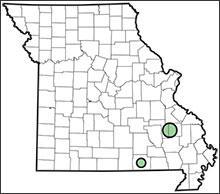
Arrowwood is a shrub native to the south-central Ozarks but should do well statewide. It has showy clusters of white flowers in May to June and blue-black berries that ripen in the fall. Many species of birds and mammals eat the fruit. This shrub attains a spread of 10 to 15 feet. It grows best on well-drained soils and will tolerate partial shade to full sun.
blackhaw
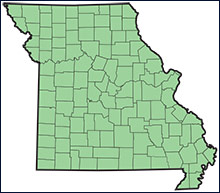
Blackhaw is a shrub that is native statewide. The leaves are dark green and flowers are rounded white clusters 2 to 4 inches across. The fruit is bluish-black clusters of ½-inch-long berries, each containing one large seed. A variety of animals feed on the fruits, leaves and stems. It grows well in sun or shade.
buttonbush
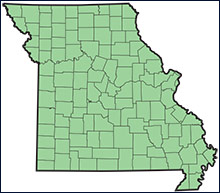
Buttonbush is found throughout the state in low, wet woods; in swamps; and along borders of streams and ponds. The flowers are fragrant, round white clusters about 1 to 1½ inches across and are a favorite nectar source for bees. Many birds eat the nutlets and nest in the branches. It does best on moist sites.
Carolina buckthorn
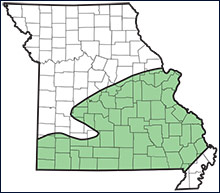
Carolina buckthorn is a shrub or small tree with oval, shiny bright green leaves that are 4 to 6 inches long. The flowers are small and not showy, but the fruit turns orange in late summer to shiny black at maturity. The fruit is eaten by a variety of woodland birds, and deer will browse the twigs. It will tolerate a wide range of soils and grows well in the shade.
chokecherry
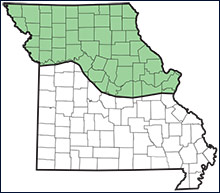
Chokecherry is a small shrub with a spread of 5 to 6 feet. It has large, shiny dark green leaves that turn purple to orange and red in the fall. Its flowers are white with five petals and about ½ inch across. It does best in full sun or partial shade, and will grow on a wide variety of soils from wet to very dry.
deciduous holly
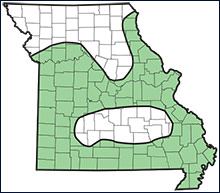
Also known as possumhaw, deciduous holly bears male and female flowers on separate plants. The bright red berries on the females are a striking bit of color on the winter landscape. The fruit is favored by a variety of birds. These characteristics, along with its site adaptability, make deciduous holly desirable for wildlife and ornamental plantings statewide.
flowering dogwood
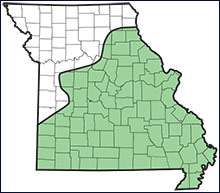
Flowering dogwood is a small tree commonly found in the understory of a woodland. It is shade tolerant, and although found naturally south of Missouri River, it can be grown statewide if give plenty of shade (on select sites). It will not tolerate flooding or very dry sites. Birds, squirrels and other animals relish the fruit, a scarlet drupe.
gray dogwood
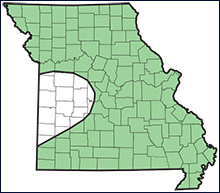
Gray dogwood is a small, almost shrublike, dogwood that does well on a variety of sites from rocky upland glades to moist prairie areas statewide. It forms thickets by underground suckers. The foliage takes on a purplish hue in autumn with clusters of white fruit borne on red stems, giving it value as an ornamental and a source of wildlife food and cover.
rough-leaved dogwood
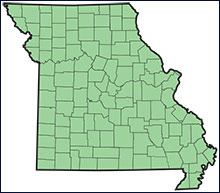
Rough-leaved dogwood, a thicket-forming shrub found statewide on a wide variety of soils, survives poor sites better than other dogwoods. Leaves are rough-textured. It does not have large white flowers like flowering dogwoods, but small white flowers appear in May. The shrub has white berries and purple-to-red fall color.
silky dogwood
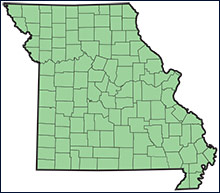
Also called swamp or pale dogwood, silky dogwood is found statewide except in the lowlands of the Bootheel. It grows in moist ground along streams, rocky banks, spring branches, swamps, wet prairies, and low, wet woods. The blue fruit is eaten by many wildlife species. It has longer, narrower leaves than other dogwoods.
elderberry
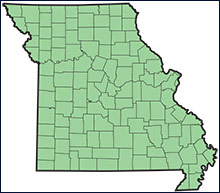
Elderberry is found throughout the state in open woods, fence rows and roadsides, and along borders of streams and ponds. The flowers are large, showy, flat-topped white clusters that appear in late May to June. Many species of birds and mammals eat the fruit, and deer browse the leaves and branches. It will tolerate both wet and dry sites.
false indigo
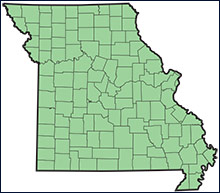
False indigo is found statewide in moist ground along streams, rocky banks and low, wet woods. This shrub is in the legume family, and the seeds are eaten by quail and other wildlife. Bees and butterflies are attracted to the dense clusters of purple tube-shaped flowers.
Washington hawthorn
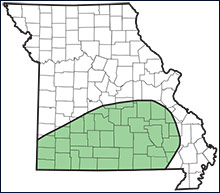
Washington hawthorn is a small- to medium-sized tree with showy white flowers in spring. Many birds and mammals eat the red fruits in the fall.
hazelnut
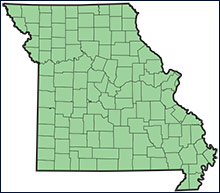
Hazelnut is a 5- to 10-foot-tall shrub that occurs in thickets on many different sites statewide. The nuts, which are also known as filberts, are a favorite of a wide range of wildlife from blue jays to deer as well as people. The foliage can be quite attractive in the autumn.
ninebark

Ninebark is a 4- to 8-foot-tall shrub with numerous small, white flowers in umbrella-like clusters. The fruit is a small dry bladder. Bark on older branches is papery and shredded. The tree produces yellow-green autumn foliage. It is tolerant of many soils and thrives in partial shade to full sun.
Ohio buckeye
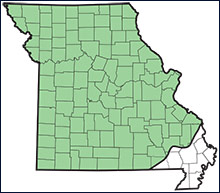
Found statewide, Ohio buckeye is among the first trees to leaf out and flower in spring and to lose its leaves in the fall. The large greenish-yellow flowers are attractive to hummingbirds. The large, shiny dark brown seeds are sometimes carried for good luck and to prevent rheumatism. It tolerates lots of shade.
Ozark witch-hazel
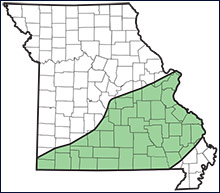
Ozark witch-hazel is a large shrub that grows as tall as 10 feet. It is found in and along dry, rocky streambeds in southern and central Missouri. It is reputed to have strange powers ranging from medicinal uses to water witching. This shrub provides wildlife food and cover and helps control erosion along streams. It is one of the earliest flowering plants in the state, often flowering in January and February. The flowers are small and yellow with ribbonlike petals.
pawpaw
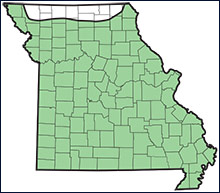
Pawpaw is small tree with large, drooping, pear-shaped leaves that are slightly aromatic. The flowers are green and inconspicuous upon opening but turn maroon as they develop. The edible yellow-green fruits are 3 to 6 inches long and ripen in September. The leaves turn bright yellow in fall.
eastern redbud
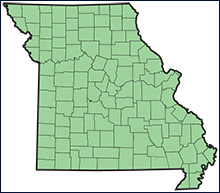
Eastern redbud is a small tree that occurs under taller trees, on the border of fields, on hillsides and in valleys throughout the state. Its stout branches usually form a wide, flat top. The conspicuous, bright purplish-red pea-shaped flowers are numerous and colorful in early spring. These flowers and the heart-shaped leaves make redbud desirable for ornamental plantings.
serviceberry
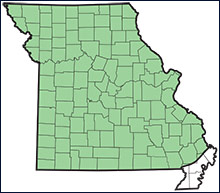
The showy white flowers of serviceberry, a large shrub or small tree, are the first to appear in Missouri woodlands each spring. The reddish sweet-tasting fruits are edible but quickly consumed by wildlife. Fall color varies from yellow to orange to red. Found statewide, it grows best in partial shade along woodland edges.
fragrant sumac
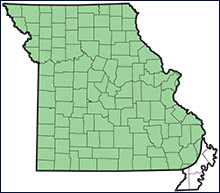
Fragrant sumac is a shrub found over much of the state, usually in thickets. The bright-red fruit ripens in late spring or early summer and is eaten by many birds.
smooth sumac

Smooth sumac is a thicket-forming shrub or small tree found statewide in old fields, prairies, woodland borders and road rights-of-way. It provides excellent wildlife food and cover. The dark-green summer foliage is followed by scarlet fall color and red berries.
eastern wahoo
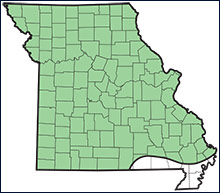
Eastern wahoo usually grows as a shrub but sometimes as a small tree. It occurs on wooded slopes and bluffs, and in open woodlands. It is found throughout Missouri except for the extreme southeast part of state. The fruit is eaten by several species of birds, including wild turkey.
wild plum
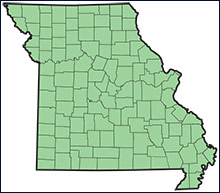
Wild plum is a small tree, 10 to 20 feet tall, that commonly occurs in thickets throughout the state. It is one of the first trees to bloom in the spring with showy white flowers. The fruit is edible. It is an excellent wildlife food and cover and erosion control plant.
Will this species grow in my soil?
Before selecting tree species to plant, you need to know what type of soil you have and what ground cover is present. Most trees and shrubs available for planting have definite soil, moisture and light requirements for best growth. Take special note of soils that have shallow impervious layers, such as claypans, and soils that are poorly drained. Trees differ greatly in soil moisture requirements, but few trees can stand poor drainage. In areas where drainage is poor in the top 18 inches of soil, most species will experience poor growth or even death.
Poor soil drainage can sometimes be predicted from soil maps but usually is determined at the proposed planting site. Dig small holes, or use a soil auger, 18 inches deep throughout the field. Yellow, brown or red soil is usually well-drained. Soil that is gray or wet-looking, or where water seeps into the hole is poorly drained. Poor drainage is also indicated by clay hardpan or subsoil often spotted, or mottled, with bright colors at depths less than 18 inches.
How many trees can I plant and properly maintain?
Determine the total area on which you plan to plant trees, and how much time and money you can spend on tree planting and maintenance each year. Then use Table 4 to determine the number of trees you will need based on the spacing needed between trees.
If you plan to plant a large number of trees, determine whether a tree planting machine can be used or the trees must be planted by hand. In an eight-hour day, two people can hand-plant about 800 trees in open agricultural land. Using a tractor and mechanical tree planter, an experienced three-person crew can plant 1,000 trees an hour under the same conditions.
If a tree planter can be used and is desired, consult your area resource forester, MU Extension center, soil conservation district, or private consulting forester for information on the availability of a planting machine.
Table 4. Maximum number of trees per acre based on spacing.
| Tree spacing | Trees per acre |
|---|---|
| 6-by-6 feet | 1,210 |
| 7-by-7 feet | 889 |
| 8-by-8 feet | 538 |
| 10-by-10 feet | 436 |
| 12-by-12 feet | 302 |
| 20-by-20 feet | 108 |
How and when do I order my trees?
Several private nurseries carry seedling trees and shrubs for conservation plantings. For a partial list of these nurseries, contact MU Extension's forestry state specialist at SNR@missouri.edu.
If you are interested in buying trees and shrubs from the state nursery, see the catalog and order form on the Missouri Department of Conservation website, or call 573-674-3229 to order a printed catalog.
The state nursery accepts seedling orders in early September for the next spring planting. In filling these orders, the nursery operates on a first-come, first-served basis. So order early as late orders of some species may be impossible to fill. Delivery procedures are explained on the seedling order form.
Is cost-sharing available for my tree planting?
At various times, cost-sharing for planting trees becomes available through the U.S. Department of Agriculture's Natural Resource Conservation Service and the Missouri Department of Conservation's Private Land Division. If you apply for cost-sharing by the designated time before the trees are planted, you might receive financial assistance. To qualify, you must have a forest management plan, follow planting specifications, and have the planting approved by a resource forester.